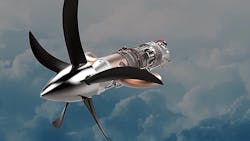GE Aviation plans to develop a new design, turboprop engine to be installed by Textron Aviation in a new series of single-engine turboprop (SETP) aircraft for business and general aviation. Textron is the Wichita-based manufacturer of Beechcraft, Cessna, and Hawker aircraft, as well as Bell Helicopters.
Textron’s SETP is seen reaching its “detailed design review” stage by 2017, and GE indicated the first full engine tests would begin in 2018.
GE plans to locate the turboprop engine development, testing and production at the new turboprop Center of Excellence it announced in September it plans to establish in Europe. Published reports have indicated GE would invest up to $1 billion in the turboprop engine development, including $400 million for the new European manufacturing center.
Textron’s new aircraft are foreseen having a range of more than 1,500 nautical miles, traveling at more than 280 knots (320 mph, or 518 km/h.)
“Our single-engine turboprop will combine the best of both clean-sheet aircraft and new engine designs. Selecting GE as our engine partner reflects the best fit for the mission of the aircraft and our commitment to reliably deliver best-in-class performance capabilities to our customers,” according to Christi Tannahill, Textron’s senior vice president, Turboprops and Interior Design.
GE Aviation is among the world’s top designers and manufacturers of jet engines for commercial, military and general aviation, including component parts and systems, but the new 1,300 shaft horse power (SHP)-rated turboprop engine will be the first in new family of 850-1,600 SHP turboprop engines for business and general aviation. It stated the new design would provide a 16:1 overall pressure ratio (OPR), which will contribute to 20% lower fuel burn and 10% higher cruise power compared to competing turboprop engines of comparable size.
Various engine design details will be drawn from GE’s military and commercial engine technologies, including an “all-titanium, 3D aero compressor”; cooled turbine blades; and structural components produced by additive manufactured, for low weight, high performance, and durability.
“For the past five years, GE conducted design studies and actively researched the turboprop market to identify and integrate the best of our next-gen commercial and military technologies at the lowest cost and risk to our business aviation customers,” stated Brad Mottier, GE Aviation's vice president and general manager for Business & General Aviation and Integrated Systems.
GE noted it continues to research a new 5,000-SHP turboprop engine for the regional aircraft market, drawing on its new GE38 turboshaft military helicopter engine, and other technologies.
About the Author
Robert Brooks
Content Director
Robert Brooks has been a business-to-business reporter, writer, editor, and columnist for more than 20 years, specializing in the primary metal and basic manufacturing industries.

